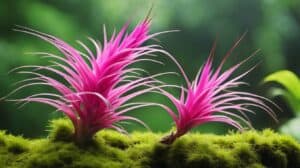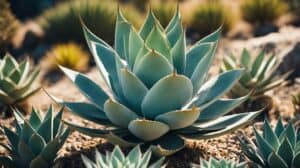Caryota Mitis, commonly known as the Fishtail Palm, is a tropical plant that is native to Southeast Asia.
It is a popular choice for novice gardeners due to its relatively low maintenance requirements and its ability to add a touch of exotic beauty to any garden or indoor space.
However, like any plant, the Fishtail Palm requires proper care to thrive and reach its full potential.

In this article, novice gardeners will find useful tips and information on how to care for their Fishtail Palm.
From watering and fertilizing to pruning and pest control, this article will provide all the necessary guidance to ensure the health and vitality of this beautiful plant.
Whether you are a seasoned gardener or just starting out, this article will help you create a lush and thriving Fishtail Palm that will be the envy of all your friends and neighbors.
Getting to Know Caryota Mitis
Species Overview
Caryota Mitis, commonly known as the Fishtail Palm, is a tropical plant native to Southeast Asia.
It belongs to the Arecaceae family and is widely cultivated as an ornamental plant due to its attractive foliage and easy maintenance.
The Fishtail Palm can grow up to 10-20 feet tall and 6-10 feet wide, making it a perfect choice for indoor or outdoor landscaping.
It is a slow-growing plant that requires minimal care, making it an ideal choice for novice gardeners.
Distinctive Features
The Fishtail Palm is known for its unique foliage, which resembles the shape of a fish’s tail.
Its leaves are pinnate, meaning they are divided into smaller leaflets that grow in a feather-like pattern.
The leaves are dark green in color and can grow up to 3-4 feet long.
Another distinctive feature of the Fishtail Palm is its trunk, which is covered in a fibrous layer that gives it a rough texture.
The trunk is also adorned with old leaf bases, giving it a unique appearance.
In conclusion, the Fishtail Palm is a beautiful and easy-to-care-for plant that is perfect for novice gardeners.
Its unique foliage and distinctive features make it a popular choice for indoor and outdoor landscaping.
Essential Care Instructions

Lighting Requirements
The Caryota Mitis, or Fishtail Palm, thrives in bright, indirect light. It can tolerate some shade, but direct sunlight can scorch its leaves.
If the plant is not receiving enough light, the leaves may turn yellow or brown.
Move the plant to a brighter location, but avoid sudden changes in lighting conditions.
Watering Routine
The Fishtail Palm prefers consistently moist soil, but avoid overwatering. Allow the top inch of soil to dry out before watering again.
In winter, reduce watering frequency. Do not let the plant sit in standing water, as this can lead to root rot.
Soil and Fertilization
The Fishtail Palm prefers well-draining soil with a pH between 6.0 and 7.5. Use a potting mix that contains perlite or sand to improve drainage.
Fertilize the plant every two to three months during the growing season with a balanced fertilizer. Do not fertilize during winter.
Temperature and Humidity
The Fishtail Palm thrives in temperatures between 65°F and 80°F (18°C and 27°C). Keep the plant away from cold drafts and air conditioning vents.
The plant prefers high humidity, so mist the leaves regularly or place a humidifier nearby.
Common Challenges

Novice gardeners might face some challenges while taking care of their Caryota Mitis or Fishtail Palm.
Here are some common challenges and tips to overcome them.
Pest Management
Fishtail Palms are susceptible to pests such as spider mites, mealybugs, and scale insects.
These pests can cause severe damage to the plant and hinder its growth. To prevent pest infestations, it is essential to keep the plant clean and healthy.
Regularly inspect the leaves for any signs of pest activity. If you spot any pests, remove them manually or use an insecticidal soap to get rid of them.
Disease Prevention
Fishtail Palms are also prone to diseases such as Fusarium wilt and leaf spot. These diseases can cause discoloration, wilting, and even death of the plant.
To prevent disease, it is crucial to maintain proper hygiene and care for the plant.
Avoid overwatering or underwatering the plant as it can lead to root rot or drought stress, which can make the plant more susceptible to diseases.
Also, ensure that the plant is not exposed to extreme temperatures or direct sunlight for prolonged periods.
By following these tips, novice gardeners can ensure that their Caryota Mitis or Fishtail Palm remains healthy and thriving.
Pruning and Maintenance

Pruning Techniques
Caryota Mitis, commonly known as the fishtail palm, requires minimal pruning.
However, it is important to remove any dead or yellowing fronds to maintain the plant’s health and appearance.
Pruning should be done in the spring or fall when the plant is not actively growing.
To prune a fishtail palm, use sharp, clean pruning shears and make cuts at an angle to prevent water from collecting on the cut surface.
Avoid cutting too close to the trunk or damaging the healthy fronds.
Repotting Tips
Caryota Mitis prefers to be slightly root-bound, so it only needs to be repotted every 2-3 years.
Repotting should be done in the spring when the plant is actively growing.
To repot a fishtail palm, choose a pot that is one size larger than the current one and has drainage holes.
Fill the bottom of the new pot with fresh potting soil and gently remove the plant from its old pot.
Loosen any tangled roots and place the plant in the new pot, adding more soil around the edges.
Water thoroughly and allow the soil to settle before adding more if necessary.
Regular maintenance of the fishtail palm includes keeping the soil moist but not waterlogged, providing bright, indirect light, and fertilizing every 2-3 months during the growing season.
With proper care, the Caryota Mitis can thrive and add a tropical touch to any garden or indoor space.
Frequently Asked Questions

How often should I water my Fishtail Palm?
Caryota Mitis requires moderate watering. In general, it is recommended to water the plant once a week.
However, the frequency of watering may vary depending on the temperature, humidity, and soil conditions.
To avoid overwatering, make sure the soil is dry to the touch before watering.
What type of soil is best for a Caryota mitis?
Fishtail Palms prefer well-draining soil that is rich in organic matter. A mixture of peat moss, perlite, and sand is ideal for the plant.
The soil should be slightly acidic with a pH range of 5.5 to 6.5.
Can Fishtail Palms be grown outdoors in cooler climates?
Caryota Mitis is a tropical plant that requires warm and humid conditions to thrive. It is not recommended to grow the plant outdoors in cooler climates.
However, the plant can be grown in a container and brought indoors during the winter months.
What are the signs of overwatering in Fishtail Palms?
Overwatering can lead to root rot, which can be fatal to the plant.
Signs of overwatering include yellowing leaves, wilting, and a foul odor coming from the soil.
To prevent overwatering, make sure the soil is well-draining and allow the soil to dry out between waterings.
Is the Fishtail Palm toxic to pets or children?
Caryota Mitis is toxic to pets and children if ingested.
The plant contains calcium oxalate crystals that can cause irritation and swelling of the mouth, tongue, and throat.
It is recommended to keep the plant out of reach of children and pets.
How can I encourage faster growth in my Fishtail Palm?
Fishtail Palms grow best in warm and humid conditions. To encourage faster growth, provide the plant with bright, indirect sunlight and keep the soil moist.
Fertilize the plant with a balanced fertilizer every two to three months during the growing season.














